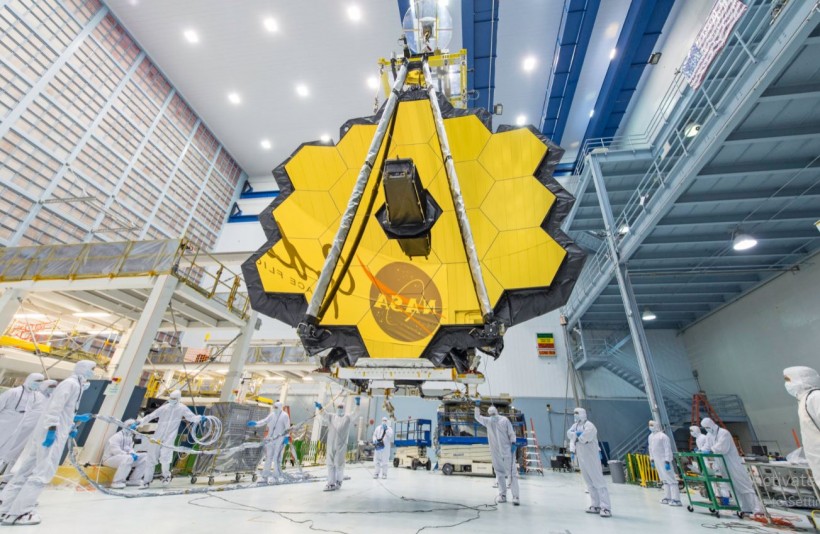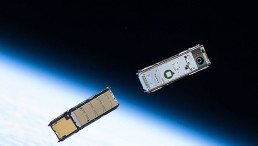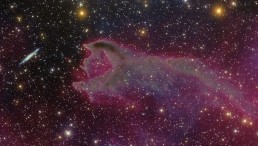JWST to Spot Biosignatures on Distant Gas Dwarfs
Scientists attending the 2021 American Physical Society (APS) Meeting said in APS Physics that they discussed how the JWST could spot biosignatures on distant gas dwarf planets, such as super-Earths and mini-Neptunes.
They predicted that when the JWST would be up and running, after its October launch, it will be able to spot ammonia signatures in about six gas dwarf planets in a matter of hours.
ALSO READ: James Webb Telescope Update: NASA Packs Sunshield for Telescope's Million Mile Trip
The existence of ammonia is just one possible biosignature that scientists expect in the current search for life in other areas of the universe. Still, the JWST's enhanced infrared sensitivity and resolution and a wider range of probing long-range sensors will make it possible for humans to have an unprecedented perspective of the universe.

The primary mirror of NASA's James Webb Space Telescope.
Gas dwarf planets are among the many possible astrobiological bets that could host the first sign of life beyond our planet, and the JWST would be the best tool to make us see it.
At the 2021 APS Meeting, scientists came up with a detailed list of their top bets for the JWST to detect, based on approximated cloud cover, atmospheric conditions, and chemical composition.
JWST Poised to Answer Mysteries of the Universe
The JWST will look into the distant past by looking at remote galaxies and other objects far away in the universe. As such, even if the JWST doesn't get to detect signs of life right away, it can help us answer other essential questions and solve longtime mysteries about the nature and origin of the universe.
Scientists will use #NASAWebb to analyze jets shooting out from young stars and learn how stars like our Sun form: https://t.co/gqvWE5JpsS ☀️ pic.twitter.com/dULGKnrl0c
— NASA Webb Telescope (@NASAWebb) April 17, 2021
The Weather Channel noted the new space telescope endured all the severe conditions that are associated with a rocket launch months before its target launch. Recent tests on the JWST confirmed that the fully assembled observatory would bear the deafening noise and the violent vibrations it will experience during the launch, NASA said.
Largest, Most Powerful Space Telescope Ever
The JWST is the world's largest, most complex, and powerful space telescope ever. It was developed to assist in finding answers to continuing paradoxes that continue to baffle scientists about the solar system, looking beyond distant worlds surrounding stars, and investigating mystifying structures and origins of the universe.
A million mile trip into space requires careful packing. 🧳
Engineers have successfully folded and packed #NASAWebb's sunshield — a heat protector the size of a tennis court. Read more about Webb's latest update at @northropgrumman: https://t.co/m0debfql4M pic.twitter.com/pzX3swlxqU— NASA Webb Telescope (@NASAWebb) April 7, 2021
Before its launch, The Atlantic reported the telescope would be shipped (literally by a ship) to a launch site in South America, traversing through the Panama Canal to reach the French Guiana. Its mirrors are as tall as a two-story building and a protective shield as large as a tennis court-it would be too large for an airplane.
More than 20 years of work has been exerted on the over $10-billion JWST, which was originally slated to launch in 2007, yet was hampered with a deluge of technical errors, budget issues, schedule delays, and a pandemic.
RELATED ARTICLE: James Webb Space Telescope Reaches Completion of Final Functional Performance Test Before Launch
Check out more news and information on the James Webb Space Telescope on Science Times.












![Venus Lost Water and Dried Out Due to Chemical Reaction HCO+ Dissociative Recombination [Study]](https://1721181113.rsc.cdn77.org/data/thumbs/full/53493/258/146/50/40/venus-lost-water-and-dried-out-due-to-chemical-reaction-hco-dissociative-recombination-study.jpeg)

